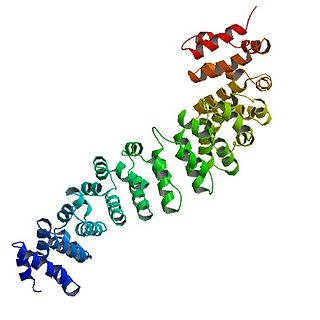The Wnt signaling pathways are a group of signal transduction pathways which begin with proteins that pass signals into a cell through cell surface receptors. The name Wnt is a portmanteau created from the names Wingless and Int-1. Wnt signaling pathways use either nearby cell-cell communication (paracrine) or same-cell communication (autocrine). They are highly evolutionarily conserved in animals, which means they are similar across animal species from fruit flies to humans.

Catenin beta-1, also known as β-catenin (beta-catenin), is a protein that in humans is encoded by the CTNNB1 gene.

Beta-catenin-interacting protein 1 is a protein that is encoded in humans by the CTNNBIP1 gene.

Axin-1 is a protein that in humans is encoded by the AXIN1 gene.

Dickkopf-related protein 1 is a protein that in humans is encoded by the DKK1 gene.

Segment polarity protein dishevelled homolog DVL-1 is a protein that in humans is encoded by the DVL1 gene.

Secreted frizzled-related protein 1, also known as SFRP1, is a protein which in humans is encoded by the SFRP1 gene.

Low-density lipoprotein receptor-related protein 6 is a protein that in humans is encoded by the LRP6 gene. LRP6 is a key component of the LRP5/LRP6/Frizzled co-receptor group that is involved in canonical Wnt pathway.

Protein Wnt-3a is a protein that in humans is encoded by the WNT3A gene.

HMG-box transcription factor 1, also known as HBP1, is a human protein.

Segment polarity protein dishevelled homolog DVL-2 is a protein that in humans is encoded by the DVL2 gene.

Segment polarity protein dishevelled homolog DVL-3 is a protein that in humans is encoded by the DVL3 gene.

Protein chibby homolog 1 is a protein that in humans is encoded by the CBY1 gene.

The LBH gene is a highly conserved human gene that produces the LBH protein, a transcription co-factor in the Wnt/β-catenin pathway. Upon transcriptional activation of β-catenin, LBH goes on to act as a regulator of cell proliferation and differentiation through multiple transcriptional targets. The gene is located on the p arm of chromosome 2 and is roughly 28 kb long. Current ongoing studies are examining its role in developmental and oncological settings.

R-spondin-1 is a secreted protein that in humans is encoded by the RSPO1 gene, found on chromosome 1. In humans, it interacts with WNT4 in the process of female sex development. Loss of function can cause female to male sex reversal. Furthermore, it promotes canonical WNT/β catenin signaling.

B-cell CLL/lymphoma 9 protein is a protein that in humans is encoded by the BCL9 gene.

Dishevelled (Dsh) is a family of proteins involved in canonical and non-canonical Wnt signalling pathways. Dsh is a cytoplasmic phosphoprotein that acts directly downstream of frizzled receptors. It takes its name from its initial discovery in flies, where a mutation in the dishevelled gene was observed to cause improper orientation of body and wing hairs. There are vertebrate homologs in zebrafish, Xenopus (Xdsh), mice and humans. Dsh relays complex Wnt signals in tissues and cells, in normal and abnormal contexts. It is thought to interact with the SPATS1 protein when regulating the Wnt Signalling pathway.

Transcription factor 7-like 1, also known as TCF7L1, is a human gene.
Kang-Yell Choi is a professor of biotechnology at Yonsei University, and has a joint appointment position as a CEO of CK Regeon Inc. in Seoul, Korea. He has been performing researches related to cellular signaling, especially for the Wnt/β-catenin pathway involving various pathophysiologies. Choi has been leading the Translational Research Center for Protein Function Control (TRCP), a Korean government supported drug development institute, as a director for 10 years. Choi has been carrying out R&D to develop agents controlling the Wnt/β-catenin signaling pathway. Choi's main interest is development of the agents to treat intractable diseases that suppress tissue regeneration system through overexpression of CXXC5 and subsequent suppression of the Wnt/β-catenin signaling.
Protein Transduction Domain-fused Dishevelled Binding Motif (PTD-DBM) is a man-made peptide which interacts with the mechanism of the hair loss linked endogenous protein, CXXC5, which is a negative feedback regulator of the Wnt/β-catenin pathway. Application of the peptide to bald laboratory mice resulted in new hair follicle growth.


















